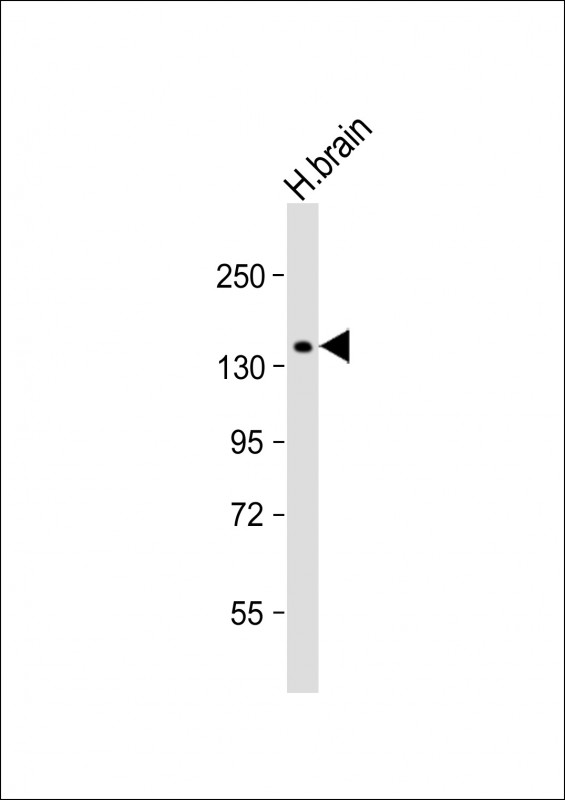MTMR4 Antibody (Center)
Affinity Purified Rabbit Polyclonal Antibody (Pab)
- SPECIFICATION
- CITATIONS
- PROTOCOLS
- BACKGROUND

Application
| WB, E |
|---|---|
| Primary Accession | Q9NYA4 |
| Other Accession | NP_004678.3 |
| Reactivity | Human |
| Host | Rabbit |
| Clonality | Polyclonal |
| Isotype | Rabbit IgG |
| Calculated MW | 133353 Da |
| Antigen Region | 695-723 aa |
| Gene ID | 9110 |
|---|---|
| Other Names | Myotubularin-related protein 4, FYVE domain-containing dual specificity protein phosphatase 2, FYVE-DSP2, Zinc finger FYVE domain-containing protein 11, MTMR4, KIAA0647, ZFYVE11 |
| Target/Specificity | This MTMR4 antibody is generated from rabbits immunized with a KLH conjugated synthetic peptide between 695-723 amino acids from the Central region of human MTMR4. |
| Dilution | WB~~1:1000 E~~Use at an assay dependent concentration. |
| Format | Purified polyclonal antibody supplied in PBS with 0.09% (W/V) sodium azide. This antibody is purified through a protein A column, followed by peptide affinity purification. |
| Storage | Maintain refrigerated at 2-8°C for up to 2 weeks. For long term storage store at -20°C in small aliquots to prevent freeze-thaw cycles. |
| Precautions | MTMR4 Antibody (Center) is for research use only and not for use in diagnostic or therapeutic procedures. |
| Name | MTMR4 (HGNC:7452) |
|---|---|
| Function | Lipid phosphatase that specifically dephosphorylates the D-3 position of phosphatidylinositol 3-phosphate and phosphatidylinositol 3,5-bisphosphate, generating phosphatidylinositol and phosphatidylinositol 5-phosphate (PubMed:11302699, PubMed:16787938, PubMed:20736309, PubMed:27625994, PubMed:29962048, PubMed:30944173). Decreases the levels of phosphatidylinositol 3-phosphate, a phospholipid found in cell membranes where it acts as key regulator of both cell signaling and intracellular membrane traffic, in a subset of endosomal membranes to negatively regulate both endocytic recycling and trafficking and/or maturation of endosomes toward lysosomes (PubMed:16787938, PubMed:20736309, PubMed:29962048). Through phosphatidylinositol 3-phosphate turnover in phagosome membranes regulates phagocytosis and phagosome maturation (PubMed:31543504). By decreasing phosphatidylinositol 3-monophosphate (PI3P) levels in immune cells it can also regulate the innate immune response (PubMed:30944173). Beside its lipid phosphatase activity, can also function as a molecular adapter to regulate midbody abscission during mitotic cytokinesis (PubMed:25659891). Can also negatively regulate TGF-beta and BMP signaling through Smad proteins dephosphorylation and retention in endosomes (PubMed:20061380, PubMed:23150675). |
| Cellular Location | Early endosome membrane; Peripheral membrane protein. Recycling endosome membrane; Peripheral membrane protein. Late endosome membrane; Peripheral membrane protein. Cytoplasmic vesicle, phagosome membrane; Peripheral membrane protein |
| Tissue Location | Expressed in brain, heart, kidney, spleen, liver, colon, testis, muscle, placenta, thyroid gland, pancreas, ovary, prostate, skin, peripheral blood, and bone marrow |

Thousands of laboratories across the world have published research that depended on the performance of antibodies from Abcepta to advance their research. Check out links to articles that cite our products in major peer-reviewed journals, organized by research category.
info@abcepta.com, and receive a free "I Love Antibodies" mug.
Provided below are standard protocols that you may find useful for product applications.
Background
Dephosphorylates proteins phosphorylated on Ser, Thr, and Tyr residues and low molecular weight phosphatase substrate para-nitrophenylphosphate. Phosphorylates phosphatidylinositol 3,4,5-trisphosphate (PIP3).
References
Yu, J., et al. J. Biol. Chem. 285(11):8454-8462(2010) Dolley, G., et al. Mol. Genet. Metab. 97(2):149-154(2009) Plant, P.J., et al. Biochem. J. 419(1):57-63(2009) Colland, F., et al. Genome Res. 14(7):1324-1332(2004) Zhao, R., et al. Exp. Cell Res. 265(2):329-338(2001)
If you have used an Abcepta product and would like to share how it has performed, please click on the "Submit Review" button and provide the requested information. Our staff will examine and post your review and contact you if needed.
If you have any additional inquiries please email technical services at tech@abcepta.com.













 Foundational characteristics of cancer include proliferation, angiogenesis, migration, evasion of apoptosis, and cellular immortality. Find key markers for these cellular processes and antibodies to detect them.
Foundational characteristics of cancer include proliferation, angiogenesis, migration, evasion of apoptosis, and cellular immortality. Find key markers for these cellular processes and antibodies to detect them. The SUMOplot™ Analysis Program predicts and scores sumoylation sites in your protein. SUMOylation is a post-translational modification involved in various cellular processes, such as nuclear-cytosolic transport, transcriptional regulation, apoptosis, protein stability, response to stress, and progression through the cell cycle.
The SUMOplot™ Analysis Program predicts and scores sumoylation sites in your protein. SUMOylation is a post-translational modification involved in various cellular processes, such as nuclear-cytosolic transport, transcriptional regulation, apoptosis, protein stability, response to stress, and progression through the cell cycle. The Autophagy Receptor Motif Plotter predicts and scores autophagy receptor binding sites in your protein. Identifying proteins connected to this pathway is critical to understanding the role of autophagy in physiological as well as pathological processes such as development, differentiation, neurodegenerative diseases, stress, infection, and cancer.
The Autophagy Receptor Motif Plotter predicts and scores autophagy receptor binding sites in your protein. Identifying proteins connected to this pathway is critical to understanding the role of autophagy in physiological as well as pathological processes such as development, differentiation, neurodegenerative diseases, stress, infection, and cancer.


